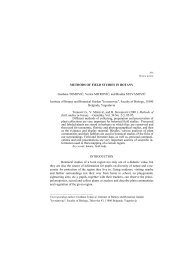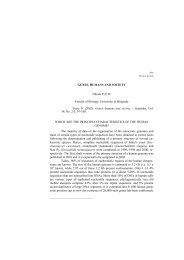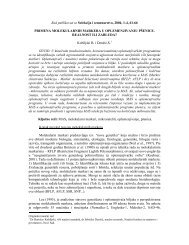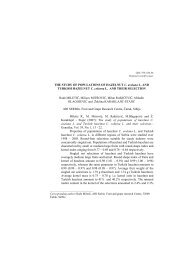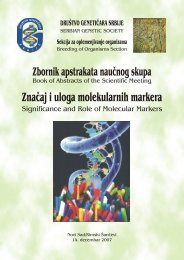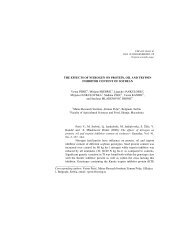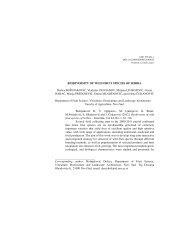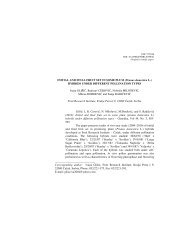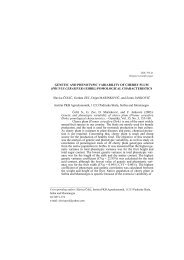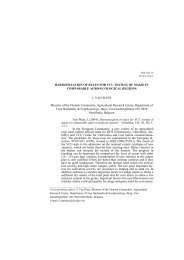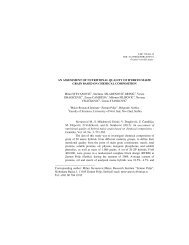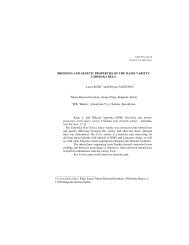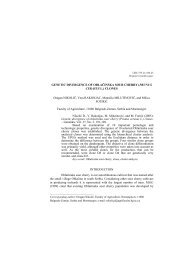Zbornik - Društvo genetičara Srbije
Zbornik - Društvo genetičara Srbije
Zbornik - Društvo genetičara Srbije
Create successful ePaper yourself
Turn your PDF publications into a flip-book with our unique Google optimized e-Paper software.
142 ZBORNIK ABSTRAKATA III KONGRESA GENETIÈARA SRBIJE IV-Pos-25<br />
Subotica, 30. novembar - 4. decembar 2004.<br />
GRUPE VEZANIH GENA I AGRONOMSKA SVOJSTVA STOÈNOG GRAŠKA<br />
(Pisum sativum L.)<br />
V. Mihailoviæ 1 , A. Mikiæ 1 , Marija Kraljeviæ-Balaliæ 2 , S. Vasiljeviæ 1 i D. Miliæ 1<br />
1<br />
Nauèni institut za ratarstvo i povrtarstvo, Zavod za krmno bilje, Novi Sad<br />
2<br />
Univerzitet u Novom Sadu, Poljoprivredni fakultet, Novi Sad<br />
Iako je grašak (Pisum sativum L.) jedna od najèešæe i najdue genetski i citogenetski<br />
prouèavanih biljnih vrsta, tek je relativno nedavno došlo do nastanka celovite slike<br />
graškovog genoma, kako u smislu kariotipa, tako i u pogledu organizacije grupa<br />
vezanosti, odnosno grupa vezanih gena (linkage groups). Grašak ima nevelik broj<br />
hromozoma (n=7), od kojih su pet akrocentrici (3, 4, 5, 6i7)idvasubmetacentrici (1 i<br />
2), ali, usled velièine biljaka i sloenosti genoma, nije mnogo omiljen u genetickoj<br />
analizi. Sa druge strane, bogat genom graška, od oko 4·10 9 bp i uz prosecni CG sadraj<br />
od 37,4 %, zajedno sa visokim stepenom samooplodnje i izraenom i lako uoèljivom<br />
morfološkom varijabilnošæu, moe da prui izuzetnu osnovu za temeljno i uspešno<br />
prouèavanje graðe genoma.<br />
Od sedam grupa vezanih gena graška, prva se vezuje za drugi, druga za šesti, treæa za<br />
peti, èetvrta za èetvrti, peta za treæi, šesta za prvi i sedma za sedmi hromozom. Ogroman<br />
doprinos razviæu genetskih mapa graška dalo je korišæenje genetskih markera, u prvom<br />
redu onih koji su zasnovani na tehnikama AFLP, RAPD, retrotranspozona ili EST.<br />
Zahvaljujuæi tome, došlo je do objedinjavanja razlièitih mapa u jedinstvenu, usaglašenu<br />
mapu vezanosti za grašak. Poslednjih godina, veliki podsticaj fundamentalnim<br />
istraivanjima daju saznanja o genomima novijih model biljaka, Medicago truncatula i<br />
Lotus japonicus, uz odreðivanje stepena sintenije izmeðu njih i ostalih mahunarki, u<br />
prvom redu graška, soèiva i nauta. Istovremeno, primena molekularnih markera postaje<br />
neprocenjiva u pronalaenju lokusa za kvantitativna svojstva (QTL), što je od<br />
izvanrednog znaèaja za efikasno oplemenjivanje.<br />
LINKAGE GROUPS AND AGRONOMIC CHARACTERISTICS<br />
OF FODDER PEA (Pisum sativum L.)<br />
Although pea (Pisum sativum L.) is one of the most frequently and most extensively<br />
studied plant species, it is only relatively recently that a coherent picture of pea genome<br />
has emerged, both in terms of karyotype and the organisation of the linkage groups. Pea<br />
has only seven chromosomes, five acrocentrics (3, 4, 5, 6 and 7) and two submetacentrics<br />
(1 and 2), but is not very popular in genetic analysis, due to plant size and complex genome.<br />
However, the richness of pea genome, with about 4·10 9 bp and the average CG<br />
content of 37.4 %, together with high level of self-pollination and noticeable morphological<br />
variability, provides an excellent basis for universal study of genome architecture.<br />
Pea has seven linkage groups, the first being linked with the second chromosome, the<br />
second with the sixth, the third with the fifth, the fourth with the fourth, the fifth with the<br />
third, the sixth with the first and the seventh group linked with the seventh chromosome.<br />
Genetic markers, especially by those AFLP, RAPD, transposone or EST based, gave an<br />
immense contribution to genetic maps development and their integration into a consensus<br />
linkage map for pea. During last few years, the fundamental research in pea was<br />
given a great stimulus by knowledge on genomes of novel model plants, Medicago<br />
truncatula and Lotus japonicus, along with the determination of level of synteny among<br />
these two and other legumes, especially pea, lentil and chickpea. At the same time, the<br />
exploitation of genetic markers becomes irreplaceable in finding out QTL, gaining an extraordinary<br />
importance in efficient breeding.



